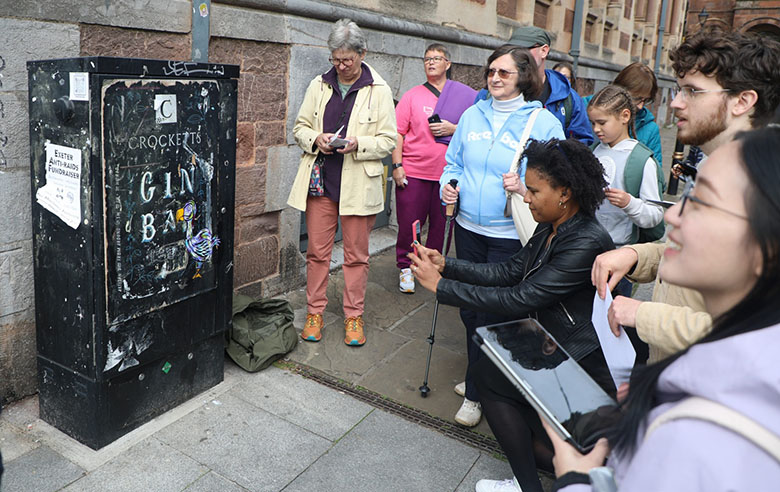Sensing Exeter’s air quality – a bird’s eye view
Authored by Jo Garrett and Hanbin Zhang.
We were recently part of an interdisciplinary team that hosted a tour through Exeter city centre exploring air quality in both creative and scientific ways.
Part of the University’s FUTURES Festival, we set off from Exeter Phoenix carrying portable air quality monitors to track changes in pollution levels as we walked.
Along the route, participants were invited to spot the paste-up works of artist Steve McCracken – featuring dodos they offered a playful and unexpected element to the experience. We found that dodo spotting was particularly effective for engaging the children who joined us. Could they spot them all?
During the walk, we explained the basics of particulate matter (PM), especially PM2.5 – tiny particles that can travel deep into our lungs and affect our health.
The World Health Organization recommends that PM2.5 levels stay below 5 micrograms per cubic metre (µg/m³) as an annual average, and below 15 µg/m³ over a 24-hour period. And levels above this can be particularly problematic for people with respiratory conditions like asthma.
As we followed the dodo trail, we compared our real-time readings to these WHO guidelines. We passed through a range of environments, including the train station, a park, high street, a cafe/bar area, and Exeter Cathedral. In some of these locations, fine particle concentrations were twice the WHO 24-hour guideline value – and several times, even higher than that.
However, since our measurements were taken in real time (second-by-second), we’d need repeated readings to make them more comparable to the 24-hour guideline.
What was most interesting was the questions these readings triggered for participants. They were interested about air quality more broadly, the kinds of pollution sources that exist in the city, and what both individuals and communities can do to improve the air we breathe.

Photos © Vance Mak
Whilst we didn’t have all the answers, these are exactly the kinds of questions we’re hoping to address in our research, such as PhD student Siyu Wang’s project focusing on indoor air quality.
We also paused to hear more from Steve McCracken about his artwork. He shared that his paste-ups are designed to brighten people’s day and offer something familiar and joyful in the urban landscape.
As a follow-up to the event, Steve plans to return to the dodos and recolour them based on the air pollution levels we recorded – adding another layer of meaning to the artwork and connecting it directly to the data we collected.
Interestingly, we noticed that PM2.5 levels were slightly higher during our second walk at 2pm compared to earlier in the day. We suspected this might be due to increased activity in nearby kitchens and food outlets – a trend that shows the unexpected ways pollution might change, even in a single day, and the importance of regular monitoring.
Overall, the event was a lively and meaningful collaboration between scientists, artists, and the public – bringing together different ways of seeing and sensing the city’s air.
Our full walking team included Dr Arthur Rose (english and creative writing), Dr Hanbin Zhang (exposure scientist), Dr Sian de Bell (public health), Dr Jo Garrett (environmental social scientist), Siyu Wang (PhD student in air pollution and health), and Hong Fan (PhD student who has just joined the Centre).
The walk was developed in collaboration with artist Steve McCracken and supported in part by the GW4 Air Network.